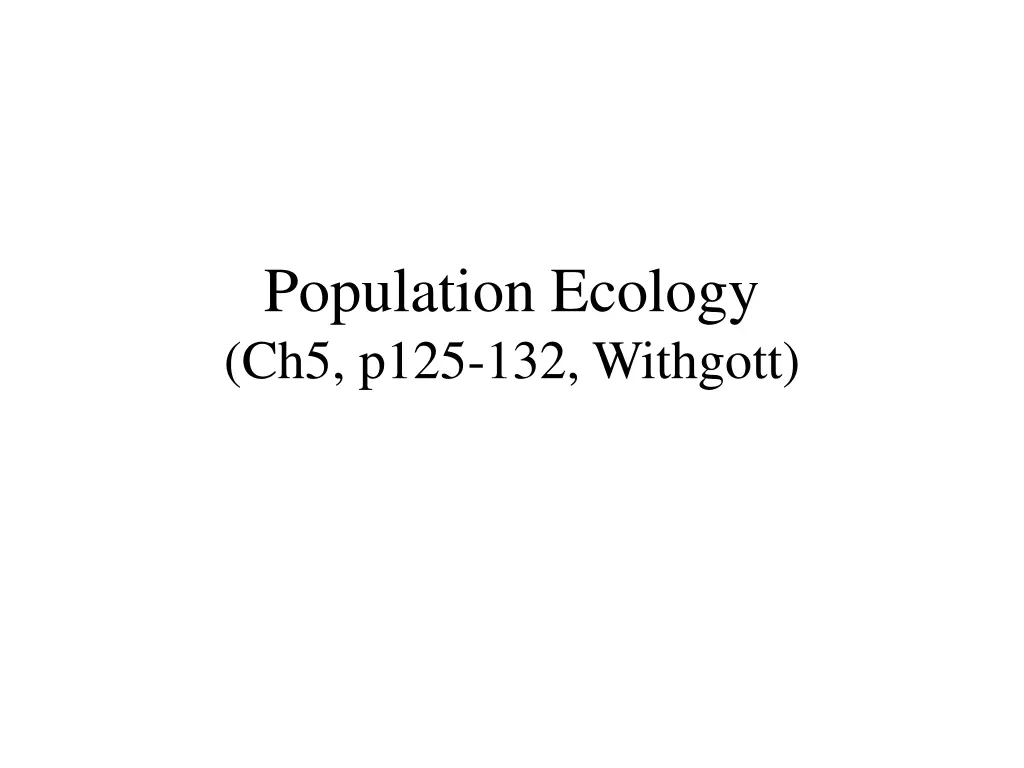
Understanding Population Ecology Concepts
Explore the key concepts of population ecology, including exponential and logistic growth, biotic potential, carrying capacity, and factors influencing population density and change. Discover how populations interact with their environments and the limits on population growth.
Download Presentation

Please find below an Image/Link to download the presentation.
The content on the website is provided AS IS for your information and personal use only. It may not be sold, licensed, or shared on other websites without obtaining consent from the author. If you encounter any issues during the download, it is possible that the publisher has removed the file from their server.
You are allowed to download the files provided on this website for personal or commercial use, subject to the condition that they are used lawfully. All files are the property of their respective owners.
The content on the website is provided AS IS for your information and personal use only. It may not be sold, licensed, or shared on other websites without obtaining consent from the author.
E N D
Presentation Transcript
Population Ecology (Ch5, p125-132, Withgott)
Population Ecology Exponential Growth- population growth that increases by a fixed percentage each year. Produces a J-shaped curve. Occurs in small populations or when conditions are ideal Logistic Growth- population growth rises sharply but will begin to level off. Environmental resistance forces that limit the growth/size of the population at the carrying capacity.
Biotic Potential Maximum reproductive rate of an organism. Of course there are limiting factors for a population. For example the common housefly can lay 120 eggs in each generation. If nothing hurt the eggs or the flies, in 7 generations there would be 6,182,442,727,320 flies.
Limits on Population Growth: Biotic Potential vs. Environmental Resistance No population can increase its size indefinitely. The intrinsic rate of increase (r) is the rate at which a population would grow if it had unlimited resources. Carrying capacity (K): the maximum population of a given species that a particular habitat can sustain indefinitely without degrading the habitat.
Exponential and Logistic Population Growth: J-Curves and S-Curves Populations grow rapidly with ample resources, but as resources become limited, its growth rate slows and levels off. Figure 8-4
Exceeding Carrying Capacity: Move, Switch Habits, or Decline in Size Over time species may increase their carrying capacity by developing adaptations. Some species maintain their carrying capacity by migrating to other areas. So far, technological, social, and other cultural changes have extended the earth s carrying capacity for humans.
Population Density and Population Change: Effects of Crowding Population density: the number of individuals in a population found in a particular area or volume. A population s density can affect how rapidly it can grow or decline. (Density Dependent Factors) e.g. biotic factors like disease Some population control factors are not affected by population density. (Density Independent Factors) e.g. abiotic factors like weather/natural disasters
Reproductive Patterns: Opportunists and Competitors Large number of smaller offspring with little parental care (r-selected species). Fewer, larger offspring with higher invested parental care (K- selected species). Figure 8-9
Reproductive Patterns r-selected species tend to be opportunists while K- selected species tend to be competitors. Figure 8-10
r-Selected Species Cockroach Dandelion Many small offspring Little or no parental care and protection of offspring Early reproductive age Most offspring die before reaching reproductive age Small adults Adapted to unstable climate and environmental conditions High population growth rate (r) Population size fluctuates wildly above and below carrying capacity (K) Generalist niche Low ability to compete Early successional species Fig. 8-10a, p. 168
K-Selected Species Elephant Saguaro Fewer, larger offspring High parental care and protection of offspring Later reproductive age Most offspring survive to reproductive age Larger adults Adapted to stable climate and environmental conditions Lower population growth rate (r) Population size fairly stable and usually close to carrying capacity (K) Specialist niche High ability to compete Late successional species Fig. 8-10b, p. 168
Survivorship Curves: Short to Long Lives The populations of different species vary in how long individual members typically live. (Type, 1, 2,3) Figure 8-11
Survivorship Curves All individuals in a population eventually die. Survivorship curves are graphs that show the likelihood at a given age. Types of Survivorship Curves Type I (Late Loss)- mostly K species Type II (Constant Loss) Type III (Early Loss) mostly r species
Late loss (Type I ) Early loss (Type III) Age Fig. 8-11, p. 169
Question of the Day A population of 100,000 frogs experiences 1800 birth per year, 600 death, 200 immigrants, and 400 emigrants. What would be its growth rate in percent per year? A. 0.5 B. 1.0 C. 1.5 D. 2.0 E. 2.5
Solution Answer: (1800 + 200) (600 + 400) Divided by 100,000 x 100 = 1 percent
